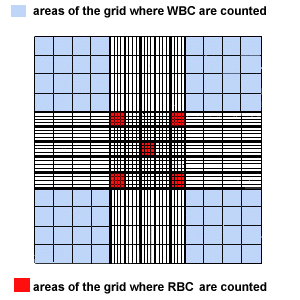|
Blood
Laboratory |
Blood cell indices
>
White cell count |
| |
The procedure for total white cell count
proceeds in exactly the same manner as that described for red cell count
except for a different dilution factor (1:20 dilution) and composition
of the dilution fluid. The diluent contains an agent (glacial acetic
acid) which lyses the red cells, allowing a proper count of white cells. |
|
Review the use of the
hemocytometer and the use of the
adjustable pipette. |
|
Observe the grid of the
hemocytometer below. White blood cells are counted in the areas coloured blue (4 corners).
Consider the following: One corner grid of 16 squares is 1mm x 1mm in area and
0.10 mm deep. The dilution factor is 1:20. How would you convert the number of white blood
cells that are counted in the four corner squares to the total number of white blood
cells/Ál? (N.B. 1 Ál (microliter) = 1 cubic mm ) |
|
How do I do this? |
 |
Click here to open a window
which
mimics what you might see looking through the 10x objective of the microscope. Only
one blue corner of the grid shown above is visible. Count the white cells in the
sixteen squares and determine the total white cell count. Note that here you are counting
in only one of the corners, and that normally you would count in all four. Note also that
a lot of debris is present on the slide, due to the lysing of red cells to allow for a
proper white cell count. In a real laboratory session, one would examine
"uncertain" elements with higher magnification to confirm that they are white
cells. |
|
The expected range for white cell count
in both males and females is as follows: |
|
|
To
continue with the next section, Differential white cell count, click
here |